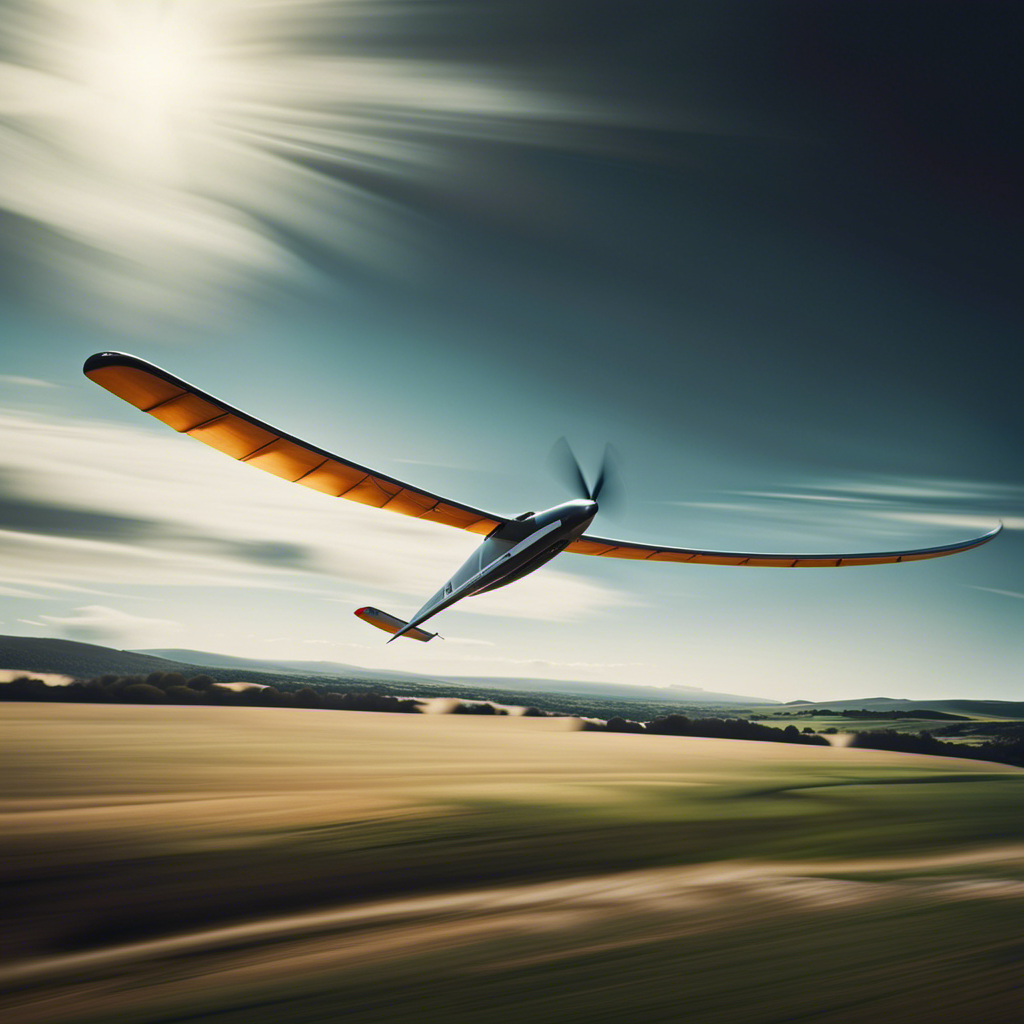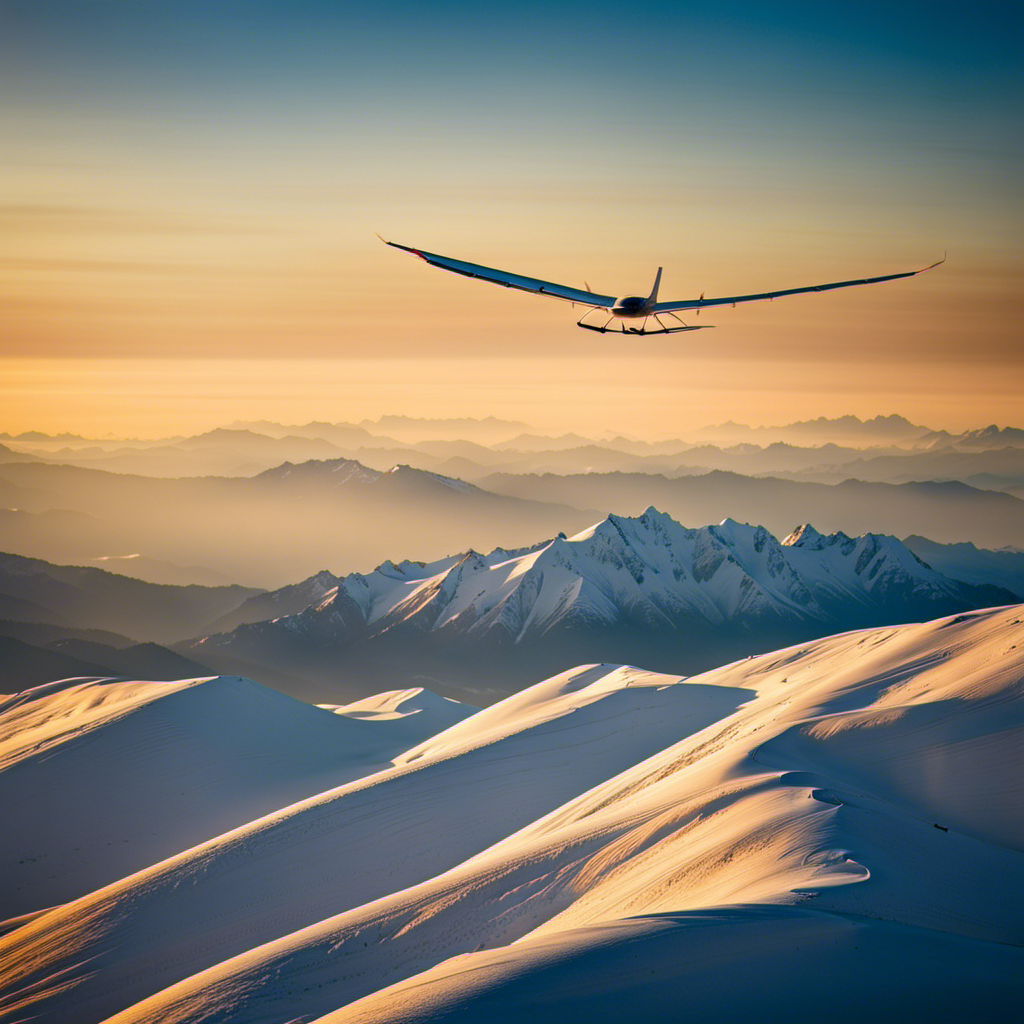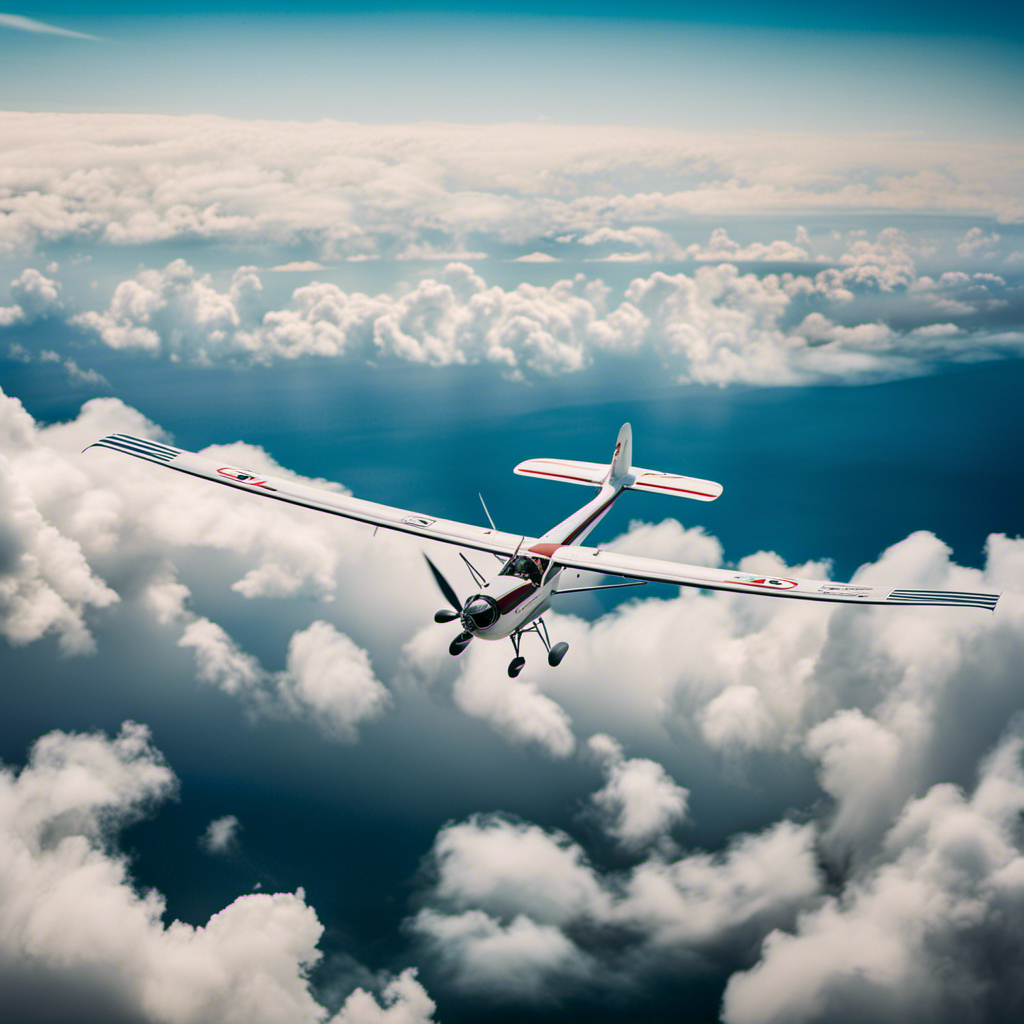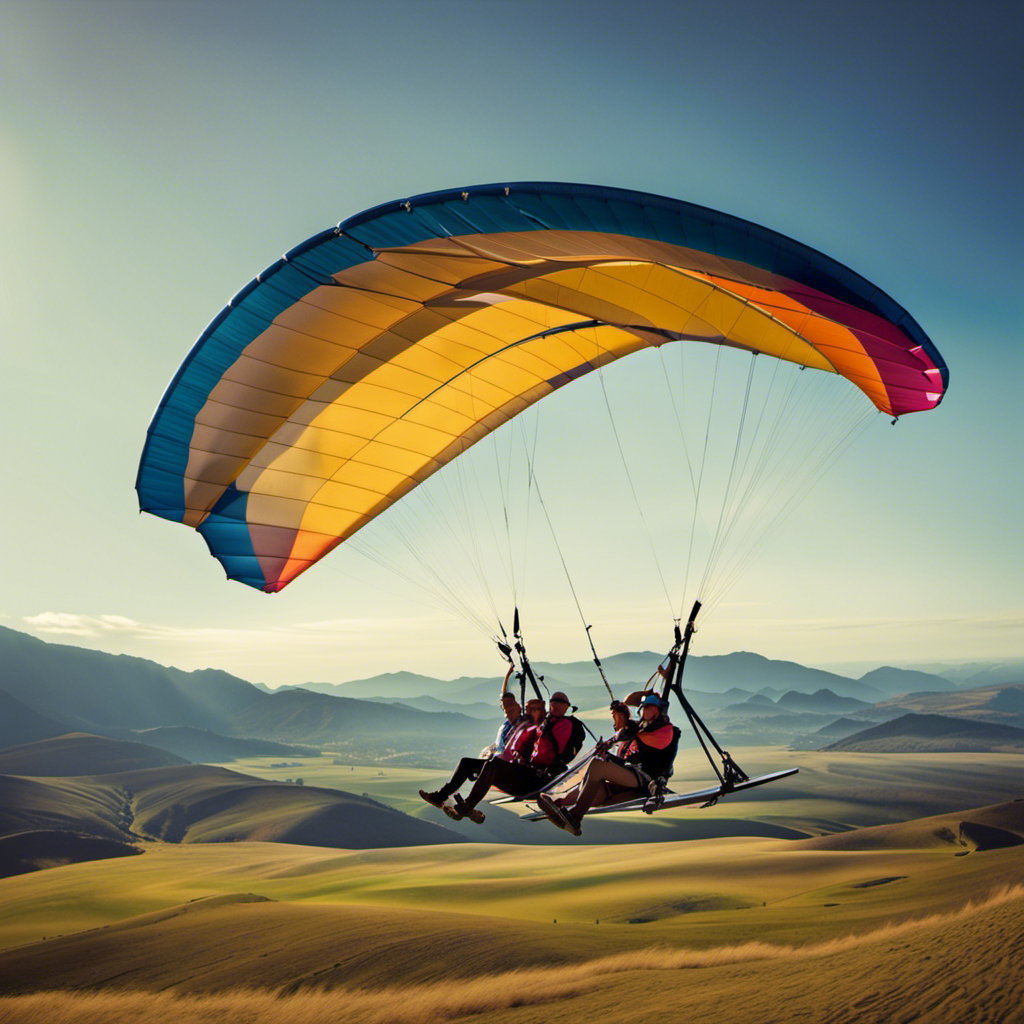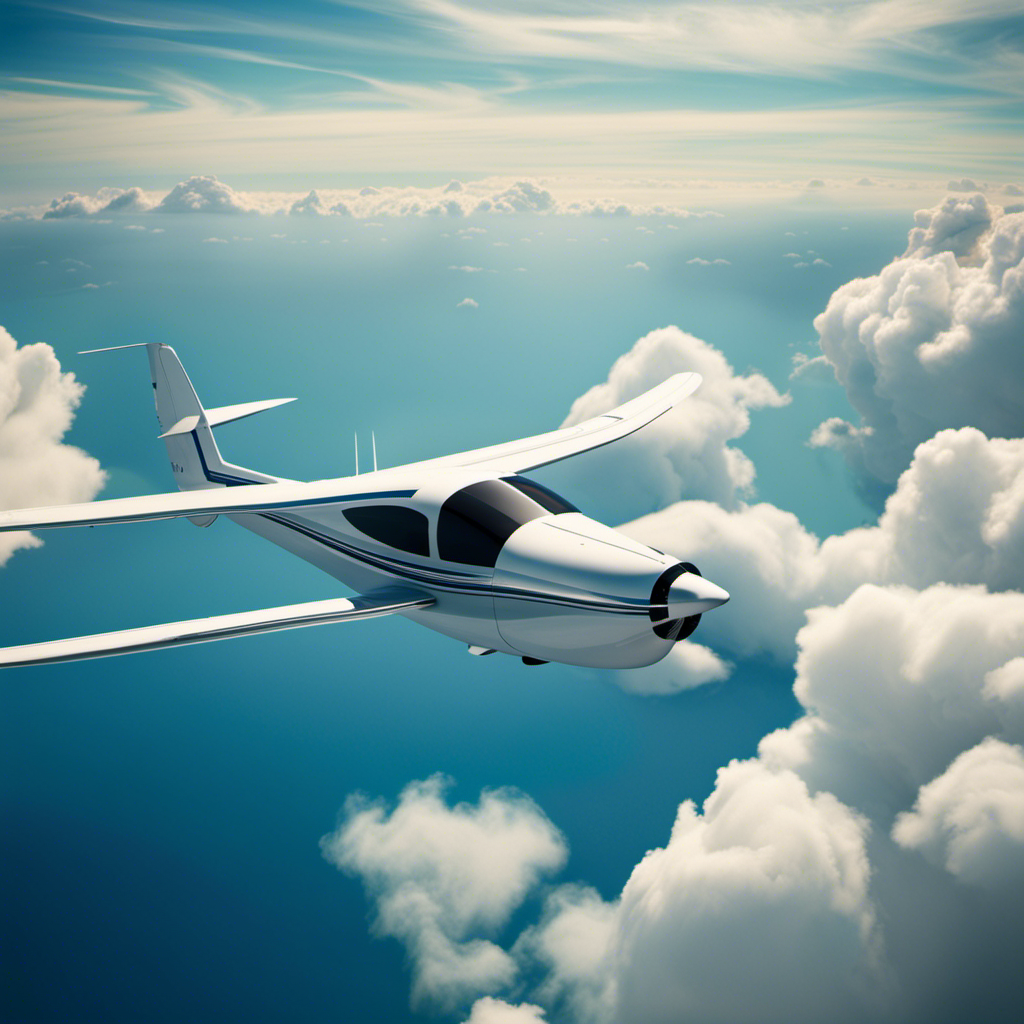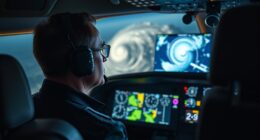Being a glider pilot, I often hear the phrase ‘The sky is the limit’ reiterated.
But just how fast can a glider actually go?
In this article, we’ll explore the factors that influence glider speed, from weather conditions to pilot skill.
We’ll delve into concepts like glide ratios and wing loading, and even touch on record-breaking speeds.
But it’s not all about speed – safety considerations at high velocities are crucial.
So buckle up and join me as we soar through the fascinating world of glider speed.
Key Takeaways
- Glider speed is affected by factors such as weight, angle of attack, weather conditions, and aerodynamic design.
- Weather conditions, including wind speed and direction, thermals, weather fronts, and cloud cover, can impact glider speed.
- Glider speed can be calculated by dividing distance traveled by time, and glide ratios are calculated by dividing distance covered by altitude lost.
- Pilot skill and flying techniques, such as energy management, optimizing trim, utilizing thermals and ridge lift, and efficient turns, can improve glider speed.
Factors that Influence Glider Speed
The weight of the glider and the angle of attack you choose will affect how fast it can go. When it comes to glider speed, there are a few key factors to consider.
Firstly, the weight of the glider plays a crucial role. The heavier the glider, the more drag it will experience, which can significantly reduce its speed.
Secondly, the angle of attack, which refers to the angle between the wing and the oncoming airflow, influences the glider’s performance. By adjusting the angle of attack, you can optimize lift and minimize drag, allowing the glider to achieve higher speeds.
Additionally, weather patterns and aerodynamic design also have an impact on glider speed. Weather conditions such as wind speed and direction can either assist or hinder the glider’s speed, while an efficient aerodynamic design can help reduce drag and maximize performance.
Considering these factors, it becomes clear that glider speed is influenced by a combination of weight, angle of attack, weather patterns, and aerodynamic design.
The Role of Weather Conditions
Weather conditions can greatly impact the maximum speed a glider can achieve. As a pilot, I know that understanding weather patterns and wind conditions is crucial for optimizing performance. Here are five key factors to consider:
-
Wind direction: The direction of the wind affects how efficiently a glider can fly. Tailwinds can increase the speed, while headwinds can decrease it.
-
Wind speed: Higher wind speeds can provide more lift, allowing a glider to reach higher speeds. However, excessive wind can also make flying more challenging and potentially dangerous.
-
Thermals: These rising columns of warm air can help gliders gain altitude and increase speed.
-
Weather fronts: The presence of weather fronts can indicate changes in wind patterns and turbulence, which can impact glider speed.
-
Cloud cover: Clouds can indicate the presence of rising air currents, which can be beneficial for gliders.
Understanding these weather conditions is essential for optimizing glide ratios and maximizing speed without compromising safety.
Understanding Glide Ratios
Glide ratios, a fundamental concept in aviation, refer to the ratio of distance covered to altitude lost while gliding. These ratios are crucial in determining the efficiency and performance of a glider. Calculating glide ratios involves dividing the distance covered by the altitude lost, providing a quantitative measure of a glider’s ability to maintain forward motion without an engine.
Understanding how glide ratios affect speed is essential since a higher glide ratio allows a glider to travel further with less altitude loss, resulting in increased speed and improved overall performance.
Definition and Calculation
To calculate the speed of a glider, you’ll need to measure the distance traveled and the time it takes. There are different calculation methods used to determine a glider’s speed.
One common method is to divide the distance traveled by the time it took to cover that distance. This will give you the average speed of the glider during that particular flight. It’s important to note that glider speed can vary depending on various factors such as weather conditions and the skill of the pilot.
When looking at historical speed records, it’s impressive to see how fast gliders can go. Some gliders have reached speeds of over 200 miles per hour!
Now, let’s delve into how glide ratios affect speed, without further ado.
How Glide Ratios Affect Speed
When it comes to calculating the speed of a glider, understanding how glide ratios affect speed is key. Glide ratio optimization plays a crucial role in determining how fast a glider can go. A glide ratio is the ratio of horizontal distance covered to vertical distance descended. By optimizing the glide ratio, pilots can achieve better efficiency and extend their range. However, it’s important to note that there are speed limitations in glider flight. Exceeding these limitations can result in structural damage or even loss of control. To give you an idea of the relationship between glide ratios and speed, take a look at the table below:
| Glide Ratio | Speed |
|---|---|
| 1:20 | 40 mph |
| 1:30 | 50 mph |
| 1:40 | 60 mph |
Understanding how glide ratios affect speed allows pilots to make informed decisions during flight, ensuring they operate within the safe limits of their glider. Transitioning to the next section, pilot skill also plays a vital role in maximizing the performance of a glider.
The Importance of Pilot Skill
When it comes to flying a glider, mastering the right techniques is crucial for efficient and safe flight.
As a pilot, I’ve learned the importance of proper energy management. This involves understanding how to gain and conserve energy during flight.
Utilizing lift effectively is another key skill to master. It allows for sustained and controlled flight without relying on engine power.
Flying Techniques
You can increase the speed of your glider by utilizing certain flying techniques. Here are some techniques that can help you achieve faster speeds:
-
Optimizing your glider’s trim: Adjusting the trim of your glider to find the most efficient angle of attack can reduce drag and increase your speed.
-
Utilizing thermals: Thermals are columns of rising air that can provide a significant boost to your glider’s speed. Learning how to identify and use thermals effectively can help you maintain and increase your speed.
-
Employing ridge lift: Flying along the edge of a ridge can create lift, allowing you to gain speed by utilizing the upward force generated by the wind hitting the ridge.
-
Practicing smooth and efficient turns: Properly executed turns can help maintain your speed and minimize energy loss.
Energy Management
To achieve efficient energy management during flight, it is important to implement strategies such as optimizing your glider’s trim and utilizing thermals and ridge lift.
Energy conservation is crucial in gliding, as it allows for extended flight durations and greater distances covered. By adjusting the trim of the glider, you can reduce drag and improve its aerodynamic performance, thus conserving energy.
Additionally, taking advantage of air currents, such as thermals and ridge lift, can provide a continuous source of upward force, reducing the need for constant propulsion. These air currents occur due to temperature and wind differentials, creating rising columns of air that the glider can ride on, effectively conserving energy throughout the flight.
Utilizing lift, generated by these air currents, is a fundamental aspect of efficient energy management in gliding.
Utilizing Lift
By harnessing the power of lift, you can effortlessly soar through the sky and cover great distances in your glider. Flying techniques and energy management play key roles in maximizing lift and optimizing your flight.
Utilizing various techniques such as thermaling, ridge soaring, and wave riding, you can effectively stay aloft for extended periods of time. Energy management involves understanding the sources of lift, such as thermal updrafts and ridge lift, and using them strategically to maintain altitude and gain speed.
It is important to constantly assess the energy state of your glider and make adjustments accordingly. By employing efficient flying techniques and effectively managing your energy, you can make the most of the available lift and extend your flight.
This leads us to the next section, where we will explore the influence of wing loading on a glider’s performance.
The Influence of Wing Loading
Wing loading is a critical factor in determining the performance and speed of an aircraft. It refers to the weight of the aircraft divided by the wing area. Calculating wing loading involves measuring the total weight of the aircraft and dividing it by the wing’s surface area.
The higher the wing loading, the faster the aircraft can potentially fly, as it indicates a greater amount of weight being supported by the wings.
Definition and Calculation
Calculating the maximum speed of a glider can be determined by various factors. To determine the speed of a glider, several calculation methods can be used, taking into account factors such as wing area, lift coefficient, and drag coefficient.
The historical speed records of gliders provide valuable insights into the potential speed capabilities of these aircraft. Some of the key factors to consider when calculating the maximum speed of a glider are:
- Wing design: The shape and size of the wings greatly influence the glider’s speed.
- Weight: The total weight of the glider affects its ability to maintain speed and maneuverability.
- Glide ratio: A higher glide ratio allows the glider to maintain speed over longer distances.
- Weather conditions: Wind speed and direction play a significant role in determining the maximum speed achievable.
Understanding the calculation methods and historical speed records can help us explore how wing loading affects speed, which will be discussed in the subsequent section.
How Wing Loading Affects Speed
The speed of a glider is influenced by how much weight is carried on its wings. Wing loading, which is the ratio of the glider’s weight to its wing area, plays a crucial role in determining the glider’s speed capabilities.
A higher wing loading means that the glider is carrying more weight per unit area of its wings, resulting in a faster flying speed. However, it’s important to note that wind effects and altitude changes also impact the glider’s speed.
Wind can either assist or hinder the glider’s forward progress, while changes in altitude can affect the glider’s lift and overall performance. Understanding how these factors interact is key to optimizing a glider’s speed potential.
Moving forward, we will explore the impact of performance modifications on glider speed.
The Impact of Performance Modifications
You can increase the speed of your glider with performance modifications like adding a larger tail. These modifications are crucial in optimizing efficiency and enhancing the overall performance of the glider. By incorporating these enhancements, you can achieve higher speeds and improve the glider’s maneuverability.
Performance modifications involve carefully analyzing and fine-tuning various aspects of the glider, such as its aerodynamics, weight distribution, and control systems. Through these modifications, you can reduce drag, increase lift, and improve stability, allowing the glider to travel faster and more efficiently through the air.
These enhancements lay the foundation for achieving record-breaking glider speeds, pushing the boundaries of what is possible in glider flight. The next section will delve into the incredible speeds that gliders have achieved, showcasing the remarkable capabilities of these soaring machines.
Record-Breaking Glider Speeds
After discussing the impact of performance modifications on glider speeds, it is fascinating to explore the realm of record-breaking achievements and the technological advancements that enable them.
Over the years, glider pilots have pushed the limits of speed, reaching astonishing velocities that seem unimaginable for an aircraft without an engine. These record-breaking achievements are a testament to the continuous pursuit of excellence in gliding.
Technological advancements in aerodynamics, materials, and instrumentation have played a crucial role in these remarkable feats. From sleeker designs and more efficient wing profiles to state-of-the-art flight computers and advanced navigation systems, every aspect of glider technology has been optimized to maximize speed and performance.
However, achieving such incredible speeds does come with its own set of safety considerations at high velocities.
Safety Considerations at High Speeds
Navigating at high speeds in a glider requires careful attention to safety considerations, as the increased velocity can pose unique challenges for pilots. To ensure a safe flight, pilots must take certain safety precautions.
First and foremost, they need to be well-trained and experienced in handling high-speed situations. Additionally, the glider must be equipped with proper safety features, such as a reliable parachute system and reinforced cockpit structure.
The aerodynamic design of the glider also plays a crucial role in ensuring safety at high speeds. The shape and structure of the glider should be optimized for stability and control, reducing the risks associated with increased velocity.
As we look to the future of glider speed, advancements in aerodynamic design and safety technology will continue to improve the overall safety of high-speed glider flights.
The Future of Glider Speed
As technology advances, gliders will continue to push the boundaries of speed, allowing for even faster and more exhilarating flights. The future of glider speed holds great promise, with numerous advancements and technological innovations on the horizon.
Here are two possibilities that could shape the future of glider speed:
-
Aerodynamic advancements: Engineers are constantly exploring ways to improve the aerodynamics of gliders, reducing drag and increasing efficiency. This could lead to gliders that can achieve higher speeds while maintaining stability and control.
-
Propulsion systems: The integration of electric propulsion systems in gliders is an area of active research. Electric motors have the potential to provide additional thrust and propulsion, enabling gliders to achieve higher speeds and longer flights.
With these future advancements and technological innovations, the speed capabilities of gliders are likely to continue expanding, offering pilots and enthusiasts an even more thrilling and dynamic flying experience.
Conclusion and Final Thoughts
As we conclude our exploration of the future of glider speed, it is clear that advancements in aerodynamic design are revolutionizing the capabilities of these aircraft.
Throughout my research, I have witnessed the tremendous progress being made in reducing drag and improving glider performance. These advancements are not only exciting for the glider community but also for pilots like myself who are passionate about pushing the boundaries of flight.
The pilot experience is being greatly enhanced by these new designs, allowing for increased speed and maneuverability. With each iteration, gliders are becoming more efficient, enabling pilots to soar through the skies at unprecedented speeds.
The future holds great promise for glider speed, and I am eager to witness the continued developments in aerodynamic design that will shape the next generation of gliders.
Frequently Asked Questions
How does the weight of the pilot affect the speed of a glider?
The weight of the pilot can significantly affect the speed of a glider. The pilot’s position and the design of the glider can both impact the aerodynamics, causing changes in glide performance and overall speed.
Can gliders go faster than powered aircraft?
Glider speed and performance can surpass that of powered aircraft due to their efficient design and ability to exploit rising air currents. This allows gliders to achieve high speeds and cover long distances without the use of an engine.
Are there any speed limitations for gliders?
There are no speed limitations for gliders. In fact, gliders have set speed records of over 900 km/h. With advancements in glider technology, the potential for even faster speeds in the future is promising.
What are the risks associated with flying at high speeds in a glider?
Flying at high speeds in a glider poses significant risks. Increased velocity can lead to loss of control, structural damage, and increased stress on the aircraft. Pilots must be aware of these dangers and take necessary precautions to ensure safe flights.
How do gliders handle different weather conditions, such as strong winds or turbulence, at high speeds?
Handling techniques and safety measures are crucial when gliding in different weather conditions. Strong winds require skilled maneuvering, like using slip techniques to counter crosswinds. Turbulence necessitates maintaining a proper attitude and using control inputs to ride it out safely.
Conclusion
In conclusion, the speed of a glider is influenced by various factors. Weather conditions, especially wind speed and direction, play a crucial role in determining how fast a glider can go. Additionally, the skill of the pilot and the wing loading of the glider have a significant impact on its speed capabilities.
It is important to consider safety considerations when pushing the limits of glider speed. Looking ahead, advancements in technology and design may continue to push the boundaries of glider speed. The future holds exciting possibilities for even faster glider speeds.
With a heart that soars as high as the skies, Aria, affectionately known as “Skylark,” is the driving force behind Soaring Skyways. Her journey into the gliding world began as a young dreamer gazing up at the soaring birds, yearning to experience the weightlessness and freedom they embodied. With years of experience both in the cockpit and behind the scenes, Aria’s commitment to the gliding community is unwavering.
